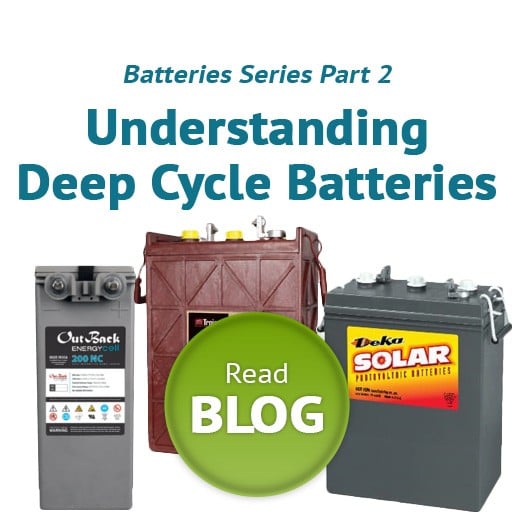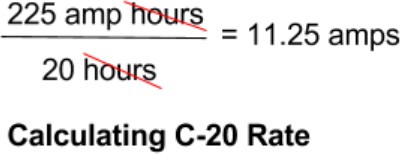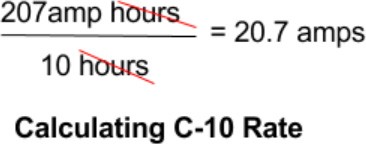
 We went over the basics of deep cycle batteries in an earlier blog, Understanding Deep Cycle Batteries – Part 1. Now let’s go a little deeper into understanding the terms used when describing actually using the batteries, charging and discharging them.
We went over the basics of deep cycle batteries in an earlier blog, Understanding Deep Cycle Batteries – Part 1. Now let’s go a little deeper into understanding the terms used when describing actually using the batteries, charging and discharging them.
Deep Cycle Batteries Charge Rate
Charge Rate, or C-rate, is a measure of how fast a battery is charged or discharged relative to its maximum capacity, or going from empty to full or full to empty. An empty 12 volt battery would be down to 10.5 volts (V). Likewise, a 6V battery is considered empty at 5.25V. Generally, when you see a battery listed at a certain amp-hour (Ah) capacity, it is usually at a 20 hour C-rate. This means it takes 20 hours to fill or empty the battery at that rate. For example, a 225 Ah (Amp-Hours) Trojan T-105-RE battery at a C-20 rate would be 225 amp-hours ÷ 20 hours = 11.25 amps (A).
The C-rate is important because the faster you charge or discharge a battery, the less energy it can store. Conversely, if you charge and discharge slowly, then it can actually store more energy than it is rated for. What this means is, if you have a battery that is rated at 225Ah at a C-20 rate (11.25A), but you have a bigger load drawing down your batteries faster than 11.25A, you will be operating at a different C-rate. You need to check the battery data sheet to see what the capacity will be at your load’s C-rate instead of C-20.
|
TROJAN T-105 RE 225Ah 6V Battery |
|||||||
| C-Rate | 2-Hr Rate | 5-Hr Rate | 10-Hr Rate | 20-Hr Rate | 48-Hr Rate | 72-Hr Rate | 100-Hr Rate |
| Amps | 73A | 37A | 20.7A | 11.25A | 5A | 3.4A | 2.5A |
| Amp-hour | 146Ah | 185Ah | 207Ah | 225Ah | 240Ah | 245Ah | 250Ah |
Charge rate for Trojan T-105 RE
You can see in the example above for a Trojan T-105-RE 6V deep cycle battery, they rate the battery C-20 rate at 225Ah. That means if the battery has an 11.25 amp load, it will last for 20 hours before the battery is empty at 5.25V. If I increase my load, and draw at the C-10 rate of 20.7A, it can only store 207Ah, not 225Ah. So using more of the power faster, virtually shrinks the battery.
If you have a slower rate of only 2.5A, that’s a C-100 rate, and the capacity actually goes up to 250Ah. So the 225Ah battery can effectively hold more power – 250Ah with the slower charge rate. It is important to know what your loads are when you are sizing a battery, so you do not misjudge how much power a battery can actually hold for your use. Take a look at an earlier blog called FIRST STEPS FOR PLANNING AN OFF THE GRID SOLAR POWER SYSTEM to help determine your system needs.
Recommended Charge Rates
If you intend to charge your batteries mainly, or only by solar panels, it’s recommended by many battery companies to properly balance the battery storage capacity with adequate solar. Too much battery for solar energy provided can result in undercharging that can reduce battery performance and life. Too little battery for the solar array can result in charging them too fast. Peak solar panel currents (Amps) between 1/10 to 1/4 of the battery “C-20” ampere hour value are often recommended, but check the specs of your battery to see what that manufacturer recommends. For example, if you have a 225Ah 12V battery bank, you want your solar array to be anywhere from:
225AH ÷ C-10 = 22.5A x 14V (charging voltage) = 315W on the low end, to
225Ah ÷ C-4 = 56.25A x 14V = 787W on the high end
The exact size of the array used would be based on your sun hours, to determine how many hours of sun are available to charge at that rate. For example, If you are just powering a summer cottage, with 5 sun hours, you can use the smaller array of 315W x 5 sun hours = 1575Wh. But if you are powering a year round cabin, and need to deal with winter with 2 sun hours, you’d need the larger array of 787W x 2 sun hours = 1574Wh. Both will provide the same amount of power when you need it, and both will charge at an acceptable C-rate for a healthy battery bank, but based on the amount of power you need and when, that will help determine the correct size.
We’ve got a video series describing how to determine the size of your system needed. You can watch the playlist for more details on system sizing at Off Grid Solar Power System Design Video Series.
If you can’t have a solar array that provides the right charging rate for your battery bank, you might want to provide an additional source such as a generator or grid tie AC battery charger to ensure that your batteries frequently get a full charge. If you have a larger solar array than is recommended to make up for low light conditions, you should use a solar charge controller that has a programmable output, that allows you to limit the current going to the battery bank in order to prevent charging at too fast of a C-rate. Or, you should increase the size of your battery bank to handle the current coming in from the solar array.
State of Charge (SoC) vs. Depth of Discharge (DoD)
State of charge is basically the opposite of depth of discharge. State of charge is how much power is left in the battery. Depth of discharge is how much power was used from the battery. A battery at 70% state of charge is at 30% depth of discharge.
Lower Depth of Discharge Equals Longer Battery Life
The deeper you discharge the battery, the shorter its life expectancy, or Life Cycles, will be. A cycle is each time you discharge the battery and charge it back up. In an off grid solar power system, a cycle is generally a day. Looking at the example chart for Concorde Battery’s life cycles, if you use it every day down to 70% DoD (or 30% SoC) you can expect about 800 cycles. At one cycle per day, that’s just over two years. But if you only use 20% of the battery daily for 80% DoD, you can expect about 2800 cycles, or almost 8 years. Despite being called Deep Cycle Batteries, lead acid batteries do not like to be discharged deeply on a regular basis.
Traditional lead acid batteries always want to be fully recharged at the end of each cycle. If they are not fully recharged, they are considered to be in a partial state of charge, which will reduce their life. Newer technology batteries are available now that tolerate being in a partial state of charge more than lead acid batteries. Some even prefer it. Salt water batteries, nickel-iron, carbon infused lead, and lithium are some examples of battery technologies that do well in a partial state of charge. We’ll talk more about these in a future blog.



